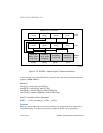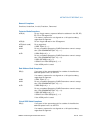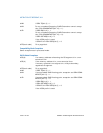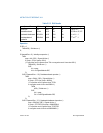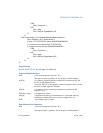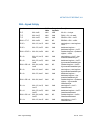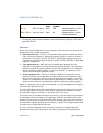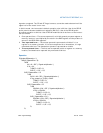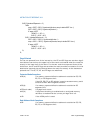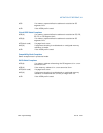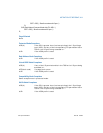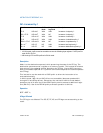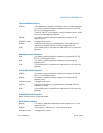
3-458 Vol. 2A IMUL—Signed Multiply
INSTRUCTION SET REFERENCE, A-M
Description
Performs a signed multiplication of two operands. This instruction has three forms,
depending on the number of operands.
• One-operand form — This form is identical to that used by the MUL instruction.
Here, the source operand (in a general-purpose register or memory location) is
multiplied by the value in the AL, AX, EAX, or RAX register (depending on the
operand size) and the product is stored in the AX, DX:AX, EDX:EAX, or RDX:RAX
registers, respectively.
• Two-operand form — With this form the destination operand (the first
operand) is multiplied by the source operand (second operand). The destination
operand is a general-purpose register and the source operand is an immediate
value, a general-purpose register, or a memory location. The product is then
stored in the destination operand location.
• Three-operand form — This form requires a destination operand (the first
operand) and two source operands (the second and the third operands). Here,
the first source operand (which can be a general-purpose register or a memory
location) is multiplied by the second source operand (an immediate value). The
product is then stored in the destination operand (a general-purpose register).
When an immediate value is used as an operand, it is sign-extended to the length of
the destination operand format.
The CF and OF flags are set when significant bit (including the sign bit) are carried
into the upper half of the result. The CF and OF flags are cleared when the result
(including the sign bit) fits exactly in the lower half of the result.
The three forms of the IMUL instruction are similar in that the length of the product
is calculated to twice the length of the operands. With the one-operand form, the
product is stored exactly in the destination. With the two- and three- operand forms,
however, the result is truncated to the length of the destination before it is stored in
the destination register. Because of this truncation, the CF or OF flag should be tested
to ensure that no significant bits are lost.
The two- and three-operand forms may also be used with unsigned operands
because the lower half of the product is the same regardless if the operands are
Opcode Instruction 64-Bit
Mode
Compat/
Leg Mode
Description
69 /r id IMUL r32, imm32 Valid Valid doubleword register ← r/m32 ∗
immediate doubleword.
REX.W + 69 /r id IMUL r64, imm32 Valid N.E. Quadword register ← r/m64 ∗
immediate doubleword.
NOTES:
* In 64-bit mode, r/m8 can not be encoded to access the following byte registers if a REX prefix is
used: AH, BH, CH, DH.



